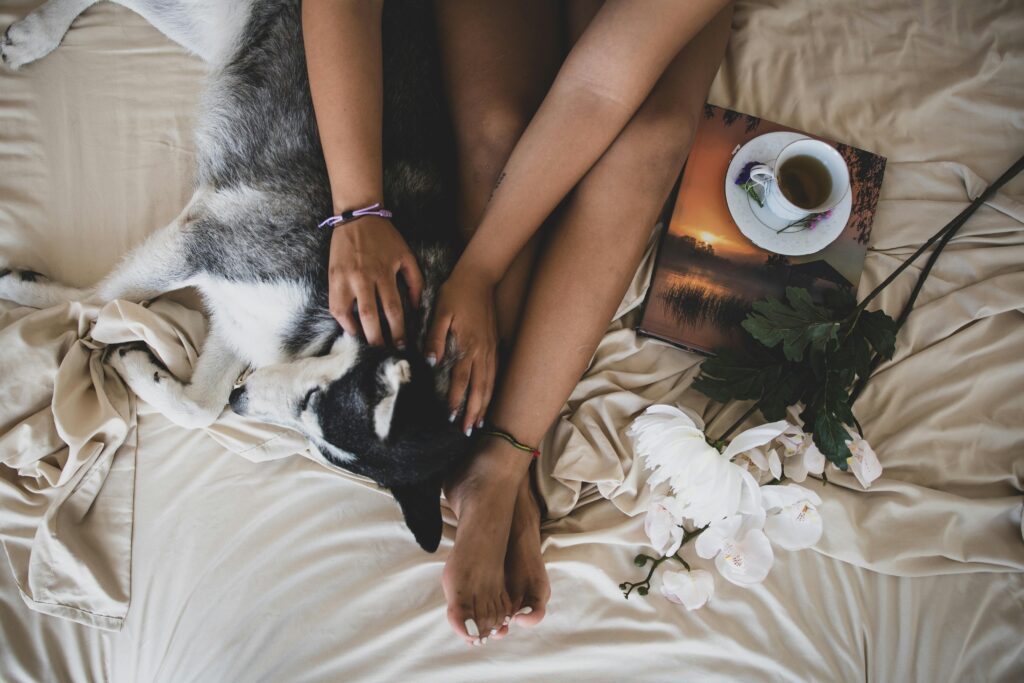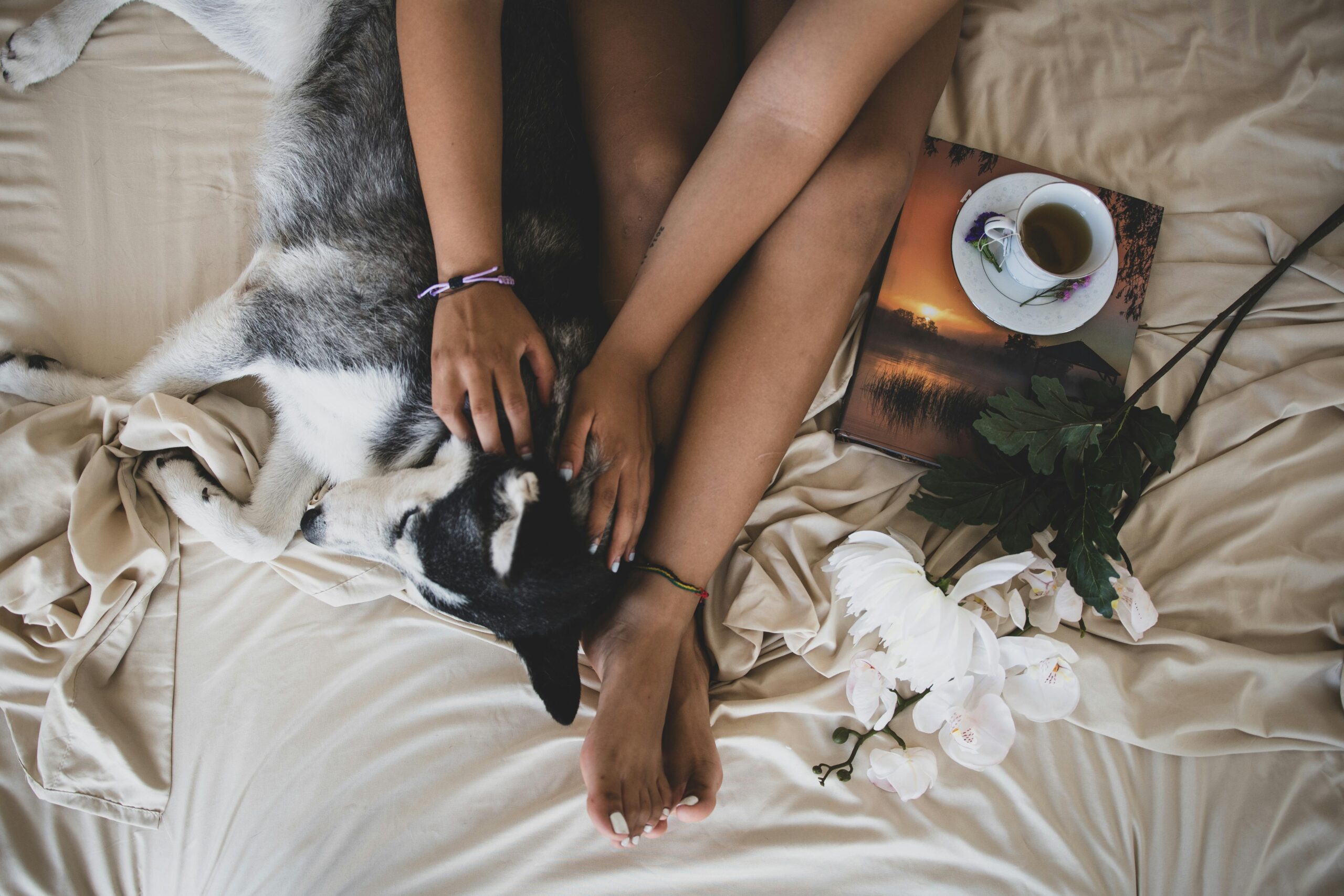As a dog owner, you may have noticed your furry friend’s peculiar choice of sleeping behind your knees.
If you’re wondering, “Why does my dog sleep behind my knees?” you’re not alone.
In this comprehensive guide, we’ll delve into 13 insightful tips to help you understand and navigate this unique sleeping preference, creating a comfortable and harmonious environment for both you and your cherished pet.
Table of Contents
Decoding Canine Behavior: Why Does My Dog Sleep Behind My Knees?

1] Seeking Security and Comfort
Dogs are instinctively drawn to areas close to their owners as it provides them with a profound sense of security and comfort.
Sleeping behind your knees allows them to feel protected and nestled in a cozy spot, reinforcing their bond with you.
This behavior often stems from the strong pack mentality ingrained in dogs, where proximity to their human “pack” members signifies safety and connection.
The warmth and closeness of this position can create a soothing environment, promoting feelings of safety and tranquility for your furry companion.
2] Temperature Regulation
The area behind your knees offers a snug and warm nook, which dogs may find particularly comforting.
Dogs are sensitive to changes in temperature, and this positioning allows them to regulate their body temperature effectively, especially if they feel a bit chilly.
The natural heat emanating from the back of your knees provides a comforting warmth, contributing to the overall appeal of this sleeping spot.
Dogs often seek out cozy places that offer a balance between warmth and comfort, and the space behind your knees can serve this purpose perfectly.
Tip: “Dogs may find this comforting, especially when they feel a bit chilly during sleep.”
3] Territorial Instincts
Dogs have a natural instinct to mark their territory, and sleeping behind your knees may be a subtle way for them to claim their space within the family unit.
This behavior is an extension of their territorial instincts, reinforcing their connection to you and their sense of belonging.
By choosing this specific location, your dog is expressing a desire to be close to you while also asserting a subtle ownership of the shared space.
It’s a non-intrusive yet meaningful way for your dog to establish their presence within the family dynamic.
4] Bonding and Affection
Sleeping close to you is a powerful bonding ritual for dogs.
The area behind your knees serves as a close, personal space where your dog can feel the reassuring presence of their human companion.
This physical closeness fosters a strong bond and reinforces the affectionate relationship between you and your dog.
The proximity allows for easy access to gentle touches, snuggles, and other comforting gestures, enhancing the emotional connection and trust between you and your furry friend.
In the embrace of your knees, a silent language of affection is spoken, and the connection between you and your dog deepens
5] Anxiety and Comfort-Seeking
If your dog experiences anxiety or stress, sleeping behind your knees can serve as a comforting ritual.
The physical closeness provides reassurance and helps alleviate feelings of unease.
Dogs often seek solace in the presence of their trusted human during times of stress.
The comforting atmosphere created by being close to you aids in soothing their nerves and contributes to a sense of security.
This behavior can be particularly pronounced during thunderstorms, fireworks, or other anxiety-inducing situations.
6] Observing the Environment
The area behind your knees offers a strategic vantage point for dogs to observe their surroundings.
This positioning allows them to keep an eye on family members, other pets, or any potential changes in the environment.
Dogs, being naturally vigilant animals, may choose this spot for sleeping to maintain a watchful eye on their surroundings even as they rest.
Tip: “This positioning allows them to keep an eye on family members, other pets, or changes in the environment.”
This behavior aligns with their protective instincts, as they can easily monitor the activities in the household from this tucked-away but observant position.
7] Natural Pack Behavior
Dogs, by nature, are pack animals.
Sleeping close to their human pack members, particularly behind the knees, aligns with their instinctual need for social connection and acceptance.
In a pack, physical closeness reinforces the bond between members and promotes a sense of unity.
By choosing to sleep in this specific location, your dog is expressing a desire to be an integral part of the family pack, seeking the comfort and security that comes from being in close proximity to their human pack leader.
8] Protective Instincts
Dogs have a natural inclination to protect vulnerable areas of their pack members.
Sleeping behind your knees allows them to fulfill this protective instinct by guarding a sensitive part of your body.
This positioning not only offers a sense of protection for your dog but also signifies their commitment to ensuring your well-being.
Dogs may instinctively position themselves in areas where they can act as guardians, and the space behind your knees serves as a conveniently nestled spot for them to carry out this protective role.
• Dogs have a natural inclination to protect vulnerable areas of their pack • Sleeping behind your knees lets them fulfill this protective instinct • Offers a sense of protection and signifies their commitment to your well-being • Instinctively, dogs may position themselves as guardians, choosing the space behind your knees for this protective role.
9] Co-Sleeping Comfort
For dogs accustomed to co-sleeping with their owners, the area behind the knees becomes a familiar and comfortable spot.
Dogs value the warmth and security of being close to their human companions during sleep.
This behavior is a testament to their social nature, as they seek the comfort of family proximity.
Co-sleeping allows for a shared sense of security and reinforces the emotional connection between you and your dog.
In the shared dreams behind your knees, co-sleeping becomes a shared journey, and the night becomes a canvas painted with familial warmth.
10] Nesting Behavior
Dogs often exhibit nesting behavior before settling down to sleep.
Sleeping behind your knees might be your dog’s way of creating a personalized sleeping space within the family nest.
This behavior involves arranging their sleeping area to their liking, whether through circling, pawing, or other nesting actions.
By choosing the space behind your knees, your dog is customizing their sleeping spot to align with their comfort preferences, contributing to a sense of ownership and familiarity.
11] Mimicking Pack Behavior
In a pack dynamic, dogs may mimic the behavior of the pack leader.
If you are perceived as the leader, your dog might choose to sleep behind your knees as a way of emulating this role.
The pack leader typically occupies a central and secure position within the group.
By positioning themselves close to you, especially in a location as vital as behind the knees, dogs are expressing a desire to mirror the behavior of the pack leader, strengthening the pack dynamic and reinforcing their role within the family structure.
Tip: “Sleeping behind your knees could be your dog’s way of emulating your role as the leader of the pack.”
12] Scent Recognition
The area behind your knees carries your scent, which is familiar and comforting to your dog.
Sleeping in this spot allows them to be surrounded by your scent, creating a sense of security.
Dogs rely heavily on their sense of smell to navigate and understand their environment.
The scent of their human is particularly reassuring, and by choosing to sleep in close proximity to the source of this familiar scent, dogs find comfort and a sense of familiarity.
The scent recognition aspect further solidifies the emotional connection between you and your furry companion.
13] Joint and Muscle Support
The contours behind your knees provide a naturally comfortable spot for your dog to rest.
It offers joint and muscle support, making it an ideal sleeping location.
Dogs, like humans, appreciate a comfortable resting place that caters to their physical well-being.
The space behind your knees allows your dog to nestle into a position that aligns with the natural contours of their body, promoting relaxation and minimizing strain on joints and muscles.
This physical comfort contributes to a restful and rejuvenating sleep experience for your canine companion.
In the gentle curve of your knees, the night unfolds into a landscape of support, where joints find solace, and muscles surrender to the embrace of rest
Why Does My Dog Sleep Behind My Knees? – FAQs
Is it normal for my dog to sleep behind my knees every night?
Yes, it’s normal for dogs to establish preferred sleeping spots, and behind your knees can be a comforting choice. However, if your dog’s behavior changes suddenly or is accompanied by signs of distress, consult with a veterinarian.
Can I encourage my dog to sleep in a different spot?
While you can gently encourage your dog to try a different sleeping spot, forcing them may cause stress. Provide cozy alternatives and use positive reinforcement to make the new spot appealing.
Should I be concerned if my dog suddenly stops sleeping behind my knees?
A sudden change in behavior can be a sign of underlying health issues or discomfort. If your dog stops sleeping behind your knees unexpectedly, monitor their overall well-being and consult with a vet if necessary.

Conclusion:
Understanding the quirks of your dog’s sleeping preferences, such as the inclination to nestle behind your knees, can deepen the bond between you and your furry friend.
The 13 tips shared in this guide serve as a toolkit for embracing and accommodating your dog’s choice of sleeping location, shedding light on the question, “Why does my dog sleep behind my knees?”
By incorporating these insights into your routine, you not only cater to your dog’s comfort but also create a warm and secure space that enhances the overall well-being of your cherished companion.
So, revel in the uniqueness of your dog’s preferences and make bedtime a cozy and delightful experience for both of you.
Also Read – Should I Let My Dog Sleep with Me?





